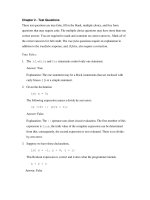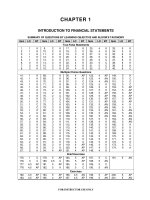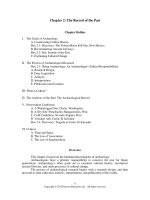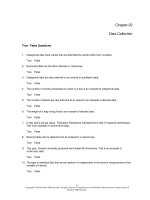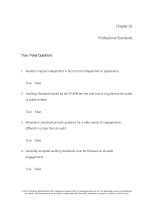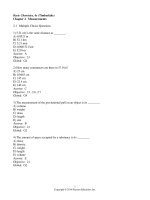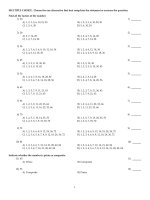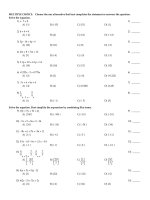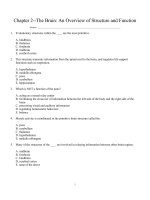Organic chemistry 5th edition smith test bank
Bạn đang xem bản rút gọn của tài liệu. Xem và tải ngay bản đầy đủ của tài liệu tại đây (256.34 KB, 13 trang )
Chapter 2 - Acids and Bases (test bank) KEY
1.
A.
B.
C.
D.
Which of the following statements is a correct definition for a Brønsted-Lowry acid?
Proton acceptor
Electron pair donor
Electron pair acceptor
Proton donor
Accessibility: Keyboard Navigation
Bloom's Level: 1. Remember
Difficulty: Easy Gradable:
automatic Section: 02.01
Subtopic:
Acid/Base
definitions
Topic: Acids and Bases
2.
A.
B.
C.
D.
Which of the following statements about a Brønsted-Lowry base is true?
The net charge may be zero, positive, or negative.
All Brønsted-Lowry bases contain a lone pair of electrons or a π bond.
All Brønsted-Lowry bases contain a proton.
The net charge may be zero or positive.
Accessibility: Keyboard Navigation
Bloom's Level: 1. Remember
Difficulty: Easy Gradable:
automatic Section: 02.01
Subtopic:
Acid/Base
definitions
Topic: Acids and Bases
3.
A.
B.
C.
D.
Which of the following compounds is both a Brønsted-Lowry acid and base?
I, II
I, III
II, IV
I, IV
Bloom's Level: 3. Apply
Difficulty: Easy
Gradable: automatic
Section: 02.01
Subtopic:
Acid/Base
definitions
Topic: Acids and Bases
4.
Which of the following species cannot act as both a Brønsted-Lowry acid and base?
A. HCO3
B. HSO4
C. HO
D. H2PO4
Accessibility: Keyboard Navigation
Bloom's Level: 3. Apply Difficulty:
Easy Gradable: automatic Section:
02.01
Subtopic:
Acid/Base
definitions
Topic: Acids and Bases
5.
Which of the following species is not a Brønsted-Lowry base?
A. BF3
B. NH3
C. H2O
3D. PO4
Accessibility: Keyboard Navigation
Bloom's Level: 3. Apply Difficulty:
Easy Gradable: automatic Section:
02.01
Subtopic:
Acid/Base
definitions
Topic: Acids and Bases
6.
A.
B.
C.
D.
Which of the following statements about Brønsted-Lowry acids and bases is true?
Loss of a proton from a base forms its conjugate acid.
Loss of a proton from an acid forms its conjugate base.
Gain of a proton by an acid forms its conjugate base.
Brønsted-Lowry acid-base reactions always result in the transfer of a proton from a base to an acid.
Accessibility: Keyboard Navigation
Bloom's Level: 3. Apply Difficulty:
Easy Gradable: automatic Section:
02.01
Subtopic:
Acid/Base
definitions
Topic: Acids and Bases
2-1
Copyright © 2016 McGraw-Hill Education. All rights reserved. No reproduction or distribution without the prior written consent of
McGraw-Hill Education.
7.
Which of the following species is the conjugate base of methanol, CH3OH?
A. CH3OH2
B. CH3O
C. CH3
D. CH4
+
Accessibility: Keyboard Navigation
Bloom's Level: 3. Apply
Difficulty: Easy
Gradable: automatic
Section: 02.01
Subtopic: Acid/Base definitions
Topic: Acids and Bases
+
Which of the following species is the conjugate base of the hydronium ion, H3O ?
8.
A. H3O
B. H2O
C. H2O
D. HO
-
Accessibility: Keyboard Navigation
Bloom's Level: 3. Apply
Difficulty: Easy
Gradable: automatic
Section: 02.01
Subtopic: Acid/Base definitions
Topic: Acids and Bases
9.
Which of the following species is the conjugate acid of ammonia, NH3?
A. H4N
+
B. H3N
C. H2N
+
D. H4N
Accessibility: Keyboard Navigation
Bloom's Level: 3. Apply
Difficulty: Easy
Gradable: automatic
Section: 02.01
Subtopic: Acid/Base definitions
Topic: Acids and Bases
10.
A.
B.
C.
D.
Which is the conjugate acid in the following reaction?
I
II
III
IV
Bloom's Level: 3. Apply
Difficulty: Easy
Gradable: automatic
Section: 02.02
Subtopic: Acid/Base definitions
Topic: Acids and Bases
11. Which is the conjugate base in the following reaction?
A.
B.
C.
D.
I
II
III
IV
Bloom's Level: 3. Apply
Difficulty: Easy
Gradable: automatic
Section: 02.02
Subtopic: Acid/Base definitions
Topic: Acids and Bases
2-2
Copyright © 2016 McGraw-Hill Education. All rights reserved. No reproduction or distribution without the prior written consent of
McGraw-Hill Education.
12.
A.
B.
C.
D.
Which is the conjugate acid in the following reaction?
I
II
III
IV
Bloom's Level: 3. Apply
Difficulty: Easy
Gradable: automatic
Section: 02.02
Subtopic: Acid/Base definitions
Topic: Acids and Bases
13.
A.
B.
C.
D.
Which is the conjugate base in the following reaction?
I
II
III
IV
Bloom's Level: 3. Apply
Difficulty: Easy
Gradable: automatic
Section: 02.02
Subtopic: Acid/Base definitions
Topic: Acids and Bases
14. Which of the following statements about acid strength is true?
A. The stronger the acid, the further the equilibrium lies to the left.
B. The stronger the acid, the smaller the Ka.
C. The stronger the acid, the larger the pKa.
D. The stronger the acid, the smaller the pKa.
Accessibility: Keyboard Navigation
Bloom's Level: 3. Apply
Difficulty: Easy
Gradable: automatic
Section: 02.03
Subtopic: Acid strength of functional groups
Subtopic: Factors affecting acid strength
Subtopic: pKa
Topic: Acids and Bases
15.
A.
B.
C.
D.
Which of the following compounds is the strongest acid?
I
II
III
IV
Bloom's Level: 3. Apply
Difficulty: Easy
Gradable: automatic
Section: 02.03
Subtopic: Acid strength of functional groups
Subtopic: Factors affecting acid strength
Subtopic: pKa
Topic: Acids and Bases
16. Which of the following compounds is the strongest acid?
A. CH3OH
B. BrCH2OH
C. CH3NH2
D. CH3Cl
Accessibility: Keyboard Navigation
Bloom's Level: 3. Apply
Difficulty: Easy
Gradable: automatic
Section: 02.03
Subtopic: Acid strength of functional groups
Subtopic: Factors affecting acid strength
Subtopic: pKa
Topic: Acids and Bases
2-3
Copyright © 2016 McGraw-Hill Education. All rights reserved. No reproduction or distribution without the prior written consent of
McGraw-Hill Education.
17. Which of the following compounds is the weakest acid?
A.
B.
C.
D.
HF
HCl
HBr
HI
Accessibility: Keyboard Navigation
Bloom's Level: 3. Apply
Difficulty: Easy
Gradable: automatic
Section: 02.03
Subtopic: Acid strength of functional groups
Subtopic: Factors affecting acid strength
Subtopic: pKa
Topic: Acids and Bases
18. Which of the following compounds is the weakest acid?
A. H2S
B. PH3
C. HCl
D. SiH4
Accessibility: Keyboard Navigation
Bloom's Level: 3. Apply
Difficulty: Easy
Gradable: automatic
Section: 02.03
Subtopic: Acid strength of functional groups
Subtopic: Factors affecting acid strength
Subtopic: pKa
Topic: Acids and Bases
19. Which of the following species is the strongest base?
A. HO
-
B. H2N
C. CH3COO
D. Cl
Accessibility: Keyboard Navigation
Bloom's Level: 3. Apply
Difficulty: Easy
Gradable: automatic
Section: 02.03
Subtopic: Acid strength of functional groups
Subtopic: Factors affecting acid strength
Subtopic: pKa
Topic: Acids and Bases
20. Which of the following ranks the compounds in order of increasing basicity, putting the least basic first?
A. CH3NH2 < CH3OH < CH4
B. CH3OH < CH3NH2 < CH4
C. CH4 < CH3NH2 < CH3OH
D. CH4 < CH3OH < CH3NH2
Accessibility: Keyboard Navigation
Bloom's Level: 3. Apply
Difficulty: Medium
Gradable: automatic
Section: 02.03
Subtopic: Acid strength of functional groups
Subtopic: Factors affecting acid strength
Subtopic: pKa
Topic: Acids and Bases
21.
A.
B.
C.
D.
Consider the following molecule with protons labeled, I-III. Rank these protons in order of decreasing acidity, putting the most acidic first.
I > II > III
I > III > II
III > II > I
III > I > II
Bloom's Level: 3. Apply
Difficulty: Medium
Gradable: automatic
Section: 02.03
Subtopic: Acid strength of functional groups
Subtopic: Factors affecting acid strength
Subtopic: pKa
Topic: Acids and Bases
2-4
Copyright © 2016 McGraw-Hill Education. All rights reserved. No reproduction or distribution without the prior written consent of
McGraw-Hill Education.
22.
A.
B.
C.
D.
Rank the following compounds in order of increasing acidity, putting the least acidic first.
III < I < IV < II
III < IV < I < II
II < I < IV < III
III < I < II < IV
Bloom's Level: 3. Apply
Difficulty: Medium
Gradable: automatic
Section: 02.03
Subtopic: Acid strength of functional groups
Subtopic: Factors affecting acid strength
Subtopic: pKa
Topic: Acids and Bases
23.
A.
B.
C.
D.
Rank the following compounds in order of increasing acidity, putting the least acidic first.
I < IV < III < II
I < III < IV < II
II < III < IV < I
II < IV < III < I
Bloom's Level: 3. Apply
Difficulty: Medium
Gradable: automatic
Section: 02.03
Subtopic: Acid strength of functional groups
Subtopic: Factors affecting acid strength
Subtopic: pKa
Topic: Acids and Bases
24.
A.
B.
C.
D.
Rank the following compounds in order of decreasing acidity, putting the most acidic first.
IV > II > III > I
III > II > IV > I
I > II > IV > III
III > IV > II > I
Bloom's Level: 3. Apply
Difficulty: Medium
Gradable: automatic
Section: 02.03
Subtopic: Acid strength of functional groups
Subtopic: Factors affecting acid strength
Subtopic: pKa
Topic: Acids and Bases
25.
A.
B.
C.
D.
Rank the following compounds in order of decreasing acidity, putting the most acidic first.
IV > II > III > I
IV > III > II > I
III > IV > II > I
III > IV > I > II
Bloom's Level: 3. Apply
Difficulty: Medium
Gradable: automatic
Section: 02.03
Subtopic: Acid strength of functional groups
Subtopic: Factors affecting acid strength
Subtopic: pKa
Topic: Acids and Bases
2-5
Copyright © 2016 McGraw-Hill Education. All rights reserved. No reproduction or distribution without the prior written consent of
McGraw-Hill Education.
26.
A.
B.
C.
D.
Rank the following conjugate bases in order of increasing basicity, putting the least basic first.
II < I < III
II < III < I
I < II < III
I < III < II
Bloom's Level: 3. Apply
Difficulty: Medium
Gradable: automatic
Section: 02.03
Subtopic: Acid strength of functional groups
Subtopic: Factors affecting acid strength
Subtopic: pKa Topic: Acids and Bases
27.
A.
B.
C.
D.
Rank the following conjugate bases in order of decreasing basicity, putting the most basic first.
II > I > III
I > II > III
III > I > II
III > II > I
Bloom's Level: 3. Apply
Difficulty: Medium
Gradable: automatic
Section: 02.03
Subtopic: Acid strength of functional groups
Subtopic: Factors affecting acid strength
Subtopic: pKa Topic: Acids and Bases
28. Which of the following is the strongest base?
A. CH3COCH3
B. CH3COOH
C. NH3
D. H2O
Accessibility: Keyboard Navigation
Bloom's Level: 3. Apply Difficulty:
Medium Gradable: automatic
Section: 02.03
Subtopic: Acid strength of functional groups
Subtopic: Factors affecting acid strength
Subtopic: pKa Topic: Acids and Bases
29.
A.
B.
C.
D.
What is the direction of equilibrium when acetylene (C2H2) reacts with H2N in an acid-base reaction?
Left
Right
Neither
Cannot be determined
Bloom's Level: 3. Apply
Difficulty: Easy
Gradable: automatic
Section: 02.04
Subtopic: Factors affecting acid strength Subtopic:
Predicting acid/base reaction equilibrium Topic:
Acids and Bases
2-6
Copyright © 2016 McGraw-Hill Education. All rights reserved. No reproduction or distribution without the prior written consent of
McGraw-Hill Education.
30.
A.
B.
C.
D.
What is the direction of equilibrium when acetylene (C2H2) reacts with ethoxide (CH3CH2O ) in an acid-base reaction?
Left
Right
Neither
Cannot be determined
Bloom's Level: 3. Apply
Difficulty: Easy
Gradable: automatic
Section: 02.04
Subtopic: Factors affecting acid strength Subtopic:
Predicting acid/base reaction equilibrium Topic:
Acids and Bases
31.
Which of the following statements explains why H2O is a stronger acid than CH4?
A. H2O can form hydrogen bonds while CH4 cannot.
B. H2O forms a less stable conjugate base, HO .
C. CH4 forms a more stable conjugate base, CH3 .
D. H2O forms a more stable conjugate base, HO .
Accessibility: Keyboard Navigation
Bloom's Level: 3. Apply Difficulty:
Easy Gradable: automatic Section:
02.05
Subtopic: Factors affecting acid strength
Topic: Acids and Bases
32. Which of the following statements explain why HBr is a stronger acid than HF?
A. Br is more stable than F because Br is larger than F .
B. Br is less stable than F because Br is larger than F .
C. Br is more stable than F because Br is less electronegative than F .
D. Br is less stable than F because Br is less electronegative than F .
Accessibility: Keyboard Navigation
Bloom's Level: 3. Apply Difficulty:
Easy Gradable: automatic Section:
02.05
Subtopic: Factors affecting acid strength
Topic: Acids and Bases
33. Which of the following compounds has the lowest pKa?
A. H2O
B. H2S
C. NH3
D. CH4
Accessibility: Keyboard Navigation
Bloom's Level: 3. Apply
Difficulty: Easy
Gradable: automatic
Section: 02.03
Subtopic: pKa
Topic: Acids and Bases
34. Which of the following concepts can be used to explain the difference in acidity between acetic acid (CH3COOH) and ethanol (CH3CH2OH)?
A.
B.
C.
D.
Hybridization
Electronegativity
Resonance
Size
Accessibility: Keyboard Navigation
Bloom's Level: 3. Apply Difficulty:
Easy Gradable: automatic Section:
02.05
Subtopic: Factors affecting acid strength
Topic: Acids and Bases
35. Which of the following concepts can be used to explain the difference in acidity between acetylene (C 2H2) and ethylene (C2H4)?
A.
B.
C.
D.
Size
Resonance
Inductive effect
Hybridization
Accessibility: Keyboard Navigation
Bloom's Level: 3. Apply Difficulty:
Easy Gradable: automatic Section:
02.05
Subtopic: Factors affecting acid strength
Topic: Acids and Bases
2-7
Copyright © 2016 McGraw-Hill Education. All rights reserved. No reproduction or distribution without the prior written consent of
McGraw-Hill Education.
36. Which of the following concepts can be used to explain the difference in acidity between ethanol (CH3CH2OH) and 2-fluoroethanol (FCH2CH2OH)?
A.
B.
C.
D.
Size
Inductive effect
Resonance
Hybridization
Accessibility: Keyboard Navigation
Bloom's Level: 3. Apply Difficulty:
Easy Gradable: automatic Section:
02.05
Subtopic: Factors affecting acid strength
Topic: Acids and Bases
37.
A.
B.
C.
D.
Rank the following compounds in order of decreasing acidity, putting the most acidic first.
I > II > III
III > II > I
II > III > I
III > I > II
Bloom's Level: 3. Apply
Difficulty: Medium
Gradable: automatic
Section: 02.05
Subtopic: Factors affecting acid strength
Topic: Acids and Bases
38. Which of the following statements about Lewis acids is true?
A.
B.
C.
D.
Lewis acids are proton donors.
Lewis acids are proton acceptors.
Lewis acids are electron pair donors.
Lewis acids are electron pair acceptors.
Accessibility: Keyboard Navigation
Bloom's Level: 2. Understand
Difficulty: Easy Gradable:
automatic Section: 02.06
Subtopic:
Acid/Base
definitions
Topic: Acids and Bases
39. Which of the following statements about Lewis bases is true?
A.
B.
C.
D.
Lewis bases are electron pair acceptors.
Lewis bases are electron pair donors.
Lewis bases are proton donors.
Lewis bases are proton acceptors.
Accessibility: Keyboard Navigation
Bloom's Level: 2. Understand
Difficulty: Easy Gradable:
automatic Section: 02.06
Subtopic:
Acid/Base
definitions
Topic: Acids and Bases
40. Which of the following is a Lewis acid but not a Brønsted-Lowry acid?
A. CH3OH
B. H2O
C. CH3COOH
D. BF3
Accessibility: Keyboard Navigation
Bloom's Level: 3. Apply Difficulty:
Easy Gradable: automatic Section:
02.06
Subtopic:
Acid/Base
definitions
Topic: Acids and Bases
2-8
Copyright © 2016 McGraw-Hill Education. All rights reserved. No reproduction or distribution without the prior written consent of
McGraw-Hill Education.
41.
A.
B.
C.
D.
Which of the following species can be both Lewis acid and Lewis base?
I, III, IV
I, II, IV
II, III, IV
I, II, III
Bloom's Level: 3. Apply
Difficulty: Easy
Gradable: automatic
Section: 02.06
Subtopic: Acid/Base definitions
Topic: Acids and Bases
42. What is the correct classification of the following compound?
CH3-O-CH3
A.
Brønsted-Lowry acid and Lewis acid
B.
Brønsted-Lowry base and Lewis base
C.
Brønsted-Lowry base
D.
Lewis base
Accessibility: Keyboard Navigation
Bloom's Level: 3. Apply
Difficulty: Easy
Gradable: automatic
Section: 02.06
Subtopic: Acid/Base definitions
Topic: Acids and Bases
43.
A.
B.
C.
D.
Identify the Lewis acid in the following reaction.
I
II
III
IV
Bloom's Level: 3. Apply
Difficulty: Easy
Gradable: automatic
Section: 02.06
Subtopic: Acid/Base definitions
Topic: Acids and Bases
44.
A.
B.
C.
D.
Identify the Lewis base in the following reaction.
I
II
III
IV
Bloom's Level: 3. Apply
Difficulty: Easy
Gradable: automatic
Section: 02.06
Subtopic: Acid/Base definitions
Topic: Acids and Bases
2-9
Copyright © 2016 McGraw-Hill Education. All rights reserved. No reproduction or distribution without the prior written consent of
McGraw-Hill Education.
45. Which of the following compounds is not a Lewis acid?
A. AlCl3
B. HCl
C. H2O
D. CBr4
Accessibility: Keyboard Navigation
Bloom's Level: 3. Apply Difficulty:
Easy Gradable: automatic Section:
02.06
Subtopic:
Acid/Base
definitions
Topic: Acids and Bases
46.
A.
B.
C.
D.
What is the role of methylchloride (CH3Cl) in the following reaction?
Lewis acid
Lewis base
Brønsted-Lowry acid
Brønsted-Lowry base
Bloom's Level: 3. Apply
Difficulty: Easy
Gradable: automatic
Section: 02.06
Subtopic:
Acid/Base
definitions
Topic: Acids and Bases
47.
A.
B.
C.
D.
What is the electrophilic site in the following compounds?
I = Carbon; II = carbon; III = boron.
I = Chlorine; II = carbon; III = boron.
I = Carbon; II = oxygen; III = boron.
I = Carbon; II = carbon; III = fluorine.
Bloom's Level: 3. Apply
Difficulty: Medium
Gradable: automatic
Section: 02.06
Subtopic:
Acid/Base
definitions
Topic: Acids and Bases
48.
A.
B.
C.
D.
What is the nucleophilic site in the following compounds?
I = Hydrogen; II = π electrons in bond; III = nitrogen.
I = Oxygen; II = carbon; III = nitrogen.
I = Hydrogen; II = carbon; III = carbon.
I = Oxygen; II = π electrons in bond; III = nitrogen.
Bloom's Level: 3. Apply
Difficulty: Medium
Gradable: automatic
Section: 02.06
Subtopic:
Acid/Base
definitions
Topic: Acids and Bases
49. What is the conjugate base of HSO4 ?
2SO4 H2SO4 SO3 H2O
I
II
III
IV
A.
B.
C.
D.
I
II
III
IV
Accessibility: Keyboard Navigation
Bloom's Level: 4. Analyze
Difficulty: Medium Gradable:
automatic Section: 02.06
Subtopic:
Acid/Base
definitions
Topic: Acids and Bases
2-10
Copyright © 2016 McGraw-Hill Education. All rights reserved. No reproduction or distribution without the prior written consent of
McGraw-Hill Education.
50.
A.
B.
C.
D.
What are the products of the following proton transfer reaction?
I
II
III
IV
Bloom's Level: 4. Analyze
Difficulty: Medium
Gradable: automatic
Section: 02.04
Subtopic: Predicting acid/base reaction equilibrium
Topic: Acids and Bases
51.
A.
B.
C.
D.
What is the correct rank of the following compounds in order of increasing acidity?
I > II > III > IV
IV > III > II > I
IV > I > II > III
III > I > IV > II
Bloom's Level: 4. Analyze
Difficulty: Hard
Gradable: automatic
Section: 02.05
Subtopic: Factors affecting acid strength
Topic: Acids and Bases
52.
A.
B.
C.
D.
Consider the following structures I-IV. Which two species represent a conjugate acid-base pair?
I and II
I and III
I and IV
II and III
Bloom's Level: 4. Analyze
Difficulty: Medium
Gradable: automatic
Section: 02.02
Subtopic: Acid/Base definitions
Topic: Acids and Bases
53.
A.
B.
C.
D.
Consider the following structures I-IV. Which two species represent resonance structures?
I and II
I and III
I and IV
II and IV
Bloom's Level: 4. Analyze
Difficulty: Medium
Gradable: automatic
Section: 02.02
Subtopic: Acid/Base definitions
Topic: Acids and Bases
2-11
Copyright © 2016 McGraw-Hill Education. All rights reserved. No reproduction or distribution without the prior written consent of
McGraw-Hill Education.
54.
A.
B.
C.
D.
Consider the following structures I-IV. Which two species represent constitutional isomers?
I and II
I and III
I and IV
II and IV
Bloom's Level: 4. Analyze
Difficulty: Medium
Gradable: automatic
Section: 02.02
Subtopic: Acid/Base definitions
Topic: Acids and Bases
2-12
Copyright © 2016 McGraw-Hill Education. All rights reserved. No reproduction or distribution without the prior written consent of
McGraw-Hill Education.
2-13
Copyright © 2016 McGraw-Hill Education. All rights reserved. No reproduction or distribution without the prior written consent of
McGraw-Hill Education.
